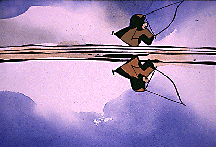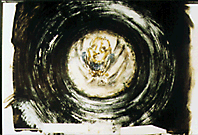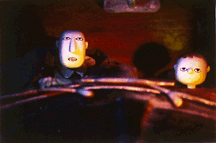Richard Taylor hosts a tour of Britain's healthy animation education system.

Let's get one thing clear. If Disney and Hanna-Barbara are the Ford and General Motors of animation, British production houses are closer to the sort of workshops that turn out four cars a week. Even companies that have had periods of successful series production have suffered from swings between boom and bust, and their output has never been sure of an international market. Thus, the UK has never had a settled system for taking trainees into an industry with a continuous demand for them. Only in the last few years have British studios banded together to provide a training course for assistant animators. But even this has been made possible only with the help of the EC organization CARTOON, and in order to be enrolled in this program, trainees must already be employed by a studio.
Entry into an animation studio, or even making any attempt to get animation experience, is much more common through one of the art colleges. We have a lot of art schools, and any reputation the UK has as a source of "cool" comes from things that have happened there, from fashion to bands.
Cool, Cool Art Schools
If I had to make a list of schools, apart from the Royal College of Art (RCA) and the National Film and Television School (NFTS), that have stood out as nurseries of animators, it would be: West Surrey, the first college to offer a BA purely in animation, Gwent in Wales, Liverpool, Harrow, St Martin's in London, and also Middlesex. All these schools change their official titles and their organization from time to time, but I have used the names by which they are generally known.
In these schools' two or three-year animation, or more often, graphics courses, students have to produce a film as evidence of successful study for their degree. This to usually a complete film, made virtually single-handedly. As a result, these students tend to learn only the technicalities and skills necessary to that one work, and they learn them not according to the production methods current in professional studios, but in a more haphazard and chancy way.

The animator who is trained in a production studio has to earn, usually over several years, the right to be in sole control of a film. The student animator, on the other hand, has the necessity forced on him or her of exposing their solo work without, perhaps, enough preparation.
Both student and studio animators do not grow food. They do not make useful pots or pans, motor cars or airplanes. They heal no illnesses. What good are they? Well, society tolerates and supports them because it needs the job they do. They communicate. They share with an audience a piece of work in picture and sound, which entertains them, informs them or persuades them.
The Student Animator
That being the job they do, it follows that the main purpose of educating animators must be to help them communicate better. This education is not just a matter of instructing and instilling skills and technical knowledge. A much larger part is played by giving students the circumstances for self-discovery. The progressive steps that occur in the UK are: a first degree course in one of the local art colleges, then a post-graduate period at either the NFTS or the RCA, then perhaps one of the commissioning schemes supported by Channel Four, MOMI (Museum of the Moving Image) and the Arts Council. Finally there is the prospect of the enlightened patronage of Channel Four and the BBC. Together these steps provide a unique climate for animators to develop into filmmakers.
Perhaps I need to say something more on this idea of self-discovery. Many students, particularly those with whom I dealt with at the RCA, come to animation with a strong and vivid pictorial imagination but little sense of joining images and ideas together in time. They have to learn how to build what is generally described as "story." Even the most abstract, moody and allusive films require a story structure. Although a teacher may emphasize this in the formal instruction that he or she gives, I have found that this is not as convincing to students as their own experience.

The trainee in a production house learns from watching the development of the films he or she works on and the eventual success or failure of those films. This learning comes with years. With students in colleges, you have to try to produce that effect quicker. Only by seeing their completed works -- not tests or experiments, but completed pieces -- can filmmakers begin to appreciate what an audience sees and feels. As an example of this theory in practice, we found at the RCA that it is useful for every student in the ten weeks of their second term to complete, through every technical stage, a coherent one-minute film. The subject of the film is either given to them or proposed by the student. The success of the work is judged by how well they achieve their stated aim. These finished, complete and public pieces, are then outside of the students. As a result, it came directly home to them how well they and their fellow students had succeeded in their stated aim of communication. That is the essential element of self-discovery. It is the discovery of yourself in relation to your audience.

Groundwork
More than twenty UK first degree art colleges have, or had, courses which allow or encourage students to try animation. These courses began in the Seventies and Eighties either within a normal graphic design course or as an offshoot from them. Sometimes the only provisions were no more than a video line tester and some available time. (Tutors of graphic design are not always tolerant of the heavy demand on time that animation makes.) The development of the video line tester was a vital ingredient to this kind of animation learning. Formal teaching by experienced professionals was uncommon. Many students finished their course with animated work in their portfolios but found themselves seen as unemployable by studios who expected the schools to have trained them in conventional methods. Talent will succeed however, and many such graduates have done well with unorthodox methods that have, in fact, influenced the mainstream. Of course, recent years have also seen the introduction of computer use, which has similarly brought change to every stage of filmmaking.
Of those who have progressed straight from their first degree to gaining broadcast commissions, I would cite Joanna Quinn whose Girls' Night Out, begun at Middlesex University, and led to Body Beautiful and then Britannia. She has recently directed Famous Fred for TVC. Michael Dudok de Wit, another West Surrey student, worked in the Richard Purdum Studio for some years before making his name with The Monk And The Fish.
Many students, after their first degree, however, choose to go on to either the RCA or the NFTS and then seek broadcast commissions. Both can be regarded as having post-graduate courses, in that applicants must have previous animation work to show. The RCA is a definitely academic institution and awards a masters degree, while the NFTS graduates receive no official diploma.
The National Film and Television School
The NFTS is a school related more closely to the film and television industries. As its name implies, it trains students for all aspects of filmmaking. Besides producing and directing, the school also has courses in camera work, sound recording, editing and so on. Before they can concentrate on their own chosen technique, all students, even those intending to specialize in animation, are required to spend part of their first year learning about every aspect of filmmaking. For animation, there is no formal teaching in the technique, but each student has an allowance of money, apart from his or her production budget, to pay for visiting teachers. (I believe, however, that this way of doing things is now changing.) Until recently the school allowed students to stay on for an unlimited time to work on their productions; the budget provided for them, however, remained fixed. Some students stayed attached to the school for several years while from time to time they worked in professional studios. Nick Park, for instance, remained at the school for around six years while finishing A Grand Day Out and working part time at Aardman Animation. The course is now limited to three years.

All work done at the school is expected to be a collaboration, and so the animators benefit from the support of editors, script-writers, sound experts and other "production" staff. This factor, and the general tooling of contact with the practical film and television world, has given the student animation work of the NFTS a strength in entertainment beyond the usual run of student work.
What sort of animators has this system produced? I must be forgiven for bringing up Nick Park again, but he is a perfect example of what I describe. Starting from a provincial art school, he gained a place at the NFTS. During his student time on A Grand Day Out, he received good industry experience with Aardman Animation. Then Channel Four came into the picture with a commission for Creature Comforts. The success of that film awakened the BBC's interest, and the other two Wallace and Gromit films were the result. Other NFTS graduates had similar transitions to professional work. Derek Hayes and Phil Austin created Animation City. David Anderson worked both with Occam Productions and Redwing. Mark Baker went from West Surrey College to production work, then to the NFTS where he had success with The Hill Farm which in turn led to Channel Four commissioning The Village. Tony Collingwood's film Rarg, made at the NFTS, led directly to a commission of a children's series by an American company.
The Royal College of Art
The course at the RCA is the one of which I can speak more accurately since I was for some years its director. The college is a unique school of art and design. It attracts very high quality students, not only from Britain, but also from the rest of the world. Courses in engineering and car design co-exist with painting, fashion, photography, film and animation. The students are there for two years, and compared with the NFTS, filmmaking budgets are small. As a comparison, an NFTS student would expect an average of £18,000 for his or her production, while at the RCA a tenth of that would be a generous estimate. In spite of that, we were able in the two years to give students the opportunity to enlarge their knowledge and develop their skills so that each of them could produce, upon graduation, a respectable film. In some cases the films were outstanding. The numbers in the course are low, with an average of ten students in each year. A personal tutorial system ensured that every one of them was continually advised on the progress of his or her production. We, the teachers, were in essence producers for the students.
All of the teaching staff are also working professional animators, with a clear idea of what graduates need in order to survive in the world. The course was designed first, to eliminate technical gaps and shortcomings, and then second, to develop strengths in picture-making and communication.
Graduate work from the RCA has also achieved some notice. With smaller budgets and less direct industrial contact, the films have naturally been more personal and esoteric. The recognition they have gained has often been at animation festivals to an audience of enthusiasts, but many have earned themselves broadcast distribution from both Channel Four and other European TV stations. An Vrombaut, whose first degree was from Gent in Belgium, produced Little Wolf, a student film that was not only professionally competent but also entertaining.

Susan Young with her film Carnival, and Jonathan Hodgson with Menagerie, both Liverpool graduates, started themselves on a steady professional career. Liverpool has sent many students onto the RCA. The course director there, Ray Field, inspired a generation of young people. He told them to ignore any technical misgivings, and sent them into the streets, parks and pubs to draw and animate directly from life. The resulting work lacked polish, but sparkled with vitality. Besides Young and Hodgson, I would mention Stuart Hilton, John Parry, Corrina Askin, Sarah Cox and Debra Smith. All of those had their RCA work bought for broadcasting and went on to gain Channel Four or Arts Council commissions. Students from other colleges whose work at the RCA attracted notice and later commissions, were Karen Kelly (Harrow) with Egoli and Stressed, Phil Hunt (St. Martine) with Spotless Dominoes and Ah Pook Is Here and Anthony Hodgson (Harrow) with Hilary and Combination Skin. Sarah Kennedy's student work has led eventually to her producing a series for Channel Four called Crapston Villas. Emma Calder and Petra Freeman are two RCA students whose nominal studies did not include animation, but whose work there has led to animation commissions. Emma was a co-founder of the Pearly Oyster production house, and Petra has made The Mill for Channel Four, and Jumping Joan for the Arts Council.
All of the RCA work I have listed has earned its makers rafts of prizes at international festivals, some limited notice from broadcasters and fragile careers as independent filmmakers intermittently involved in commercial or series production. It has not made any of them big bucks.
Past the Classroom
Finally, there are two factors which have influenced the development of young animators in the UK over the last twenty years. The first is the advertising industry which has funded a variety of witty and stylish studios, so that there are adventurous models to follow. The other is the enormous influence of Channel Four Television. In the true spirit of the Channel's official remit to encourage experimentation and innovation, Paul Madden, followed by Clare Kitson, have commissioned, purchased and shown the best in animation from all over the world. Their names are rightly honored by all animators.
A commission to complete one's own film is an admirable goal. Its completion is not likely to lead to a pile of riches but will add to the world's wealth of animation and probably some studio work for the filmmaker. We are fortunate in the UK to have these opportunities to create a vibrant and active independentanimation culture.
Richard Taylor has been an animator since 1953. He is the current president of ASIFA UK. Beginning as a maker of commercials, he later specialized in information and educational productions. In 1987 he joined Bob Godfrey as head of animation at the Royal College of Art, and succeeded him as professor from 1992-94.







